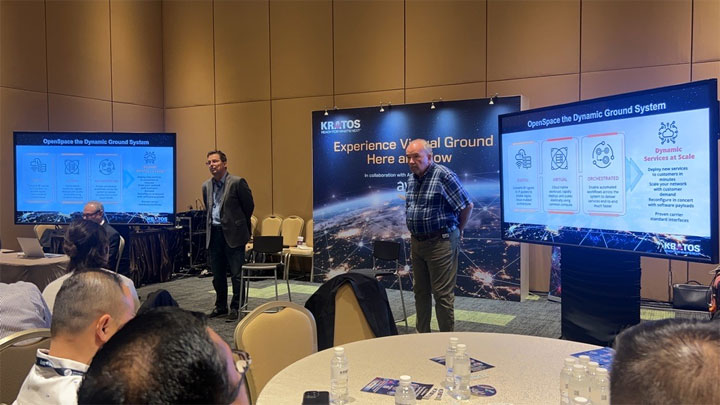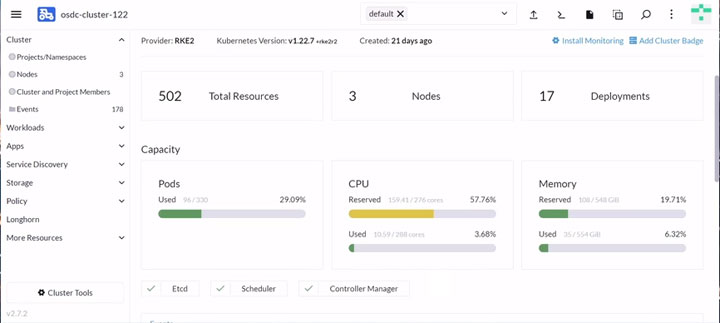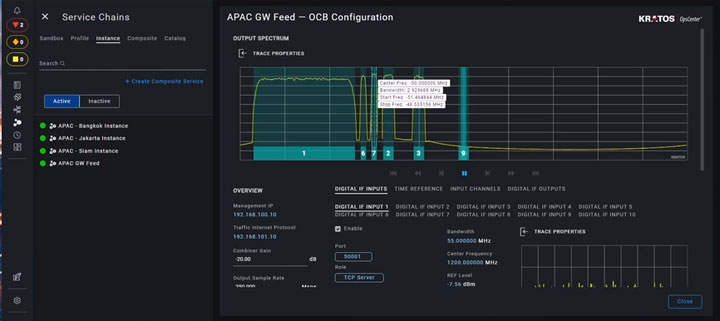SINGAPORE — What happens when a ground station operator has a sudden spike in demand for satcom services? A natural disaster strikes and an entire region is dependent on satellite for emergency communications services. Hundreds of millions of people around the globe tune in for the sports match of the century in real time. A small startup suddenly takes off and maxes out capacity.
In a traditional gateway, responding to these situations would involve a lot of lead time and a major investment in hardware components that will sit unused, except during peak demand. However, proponents of virtual ground systems have argued that is unnecessary when that hardware can be deployed as software on local servers, edge devices or the cloud on demand.
 (Left to right) Thomas Muller of Kratos, Greg Quiggle of Kratos and Bill Carlin of AWS demonstrated virtual satellite ground capabilities over cloud in Singapore on June 8, 2023. (Source: Kratos)
(Left to right) Thomas Muller of Kratos, Greg Quiggle of Kratos and Bill Carlin of AWS demonstrated virtual satellite ground capabilities over cloud in Singapore on June 8, 2023. (Source: Kratos)
That was the premise of a June 8 technology demonstration hosted by Kratos and AWS on the sidelines of SatelliteAsia in Singapore. The audience at the invitation-only demo saw how a satellite network operator could rapidly “spin up” a virtual modem and establish a new satcom link using a software platform running on general purpose compute in the AWS cloud.
The cloud demo began with a single link to a virtual modem deployed on AWS, connected via the internet to a virtual combiner running on the Kratos OpenSpace® software platform. The point-and-click user interfaces were open in a couple of browser windows, letting users monitor service chains, incoming signals and available capacity within a given data cluster.
To fire up the new link, a user selected a preconfigured modem from a menu, named it and was given the option to schedule it to run immediately or only for a particular timeframe. Less than a minute after confirming the selection, the new signal began flowing and users could see an increase in CPU and memory usage confirming the link was active.
Instantiating and then deactivating a satcom link from a conference room in Singapore, running a virtual modem on AWS connecting to a hub in Bangkok showed the “flexibility” of virtual ground, said Thomas Muller, Director of Commercial Satcom Solutions at Kratos. The single-screen demo also suggested how to leverage virtualization, standards-based technologies and the cloud to expand the functionality of the ground segment to keep pace with rapid advancements in the space layer and interoperate with adjacent industries.
 A screenshot of the Rancher RKE2 platform showing active CPU consumption of the OpenSpace Data Path cluster during a demonstration by Kratos and AWS to show how to “spin up” a virtual modem and establish an active satcom link over cloud. (Source: Kratos)
A screenshot of the Rancher RKE2 platform showing active CPU consumption of the OpenSpace Data Path cluster during a demonstration by Kratos and AWS to show how to “spin up” a virtual modem and establish an active satcom link over cloud. (Source: Kratos)
“The idea is, it’s not static. It’s not stuck in a particular planning cycle. You’re able to react dynamically,” said Global Satellite Solutions Lead for AWS Bill Carlin. “What we’re trying to do in cloud is offer you flexibility, the ability to turn it on, turn it off, have it operate in one place, then another or both, or 25 [places] all at a time.”
Both Kratos and AWS presenters described opportunities for cloud-enabled ground systems to offer new satellite service that have not been feasible economically or technologically. Kratos Senior Vice President of Product Management Greg Quiggle described a use case for a satellite gateway operator to allocate bandwidth to a customer over the cloud. If the customer needs 10 MHz of capacity, the operator can configure that allocation on a virtual channelizer and send it through the cloud. The customer can then orchestrate a modem and utilize the capacity only when it’s needed. This frees the satellite operator from orchestrating that particular hub and allows the customer to instantiate service independently.
“This creates a whole new class of occasional-use services,” Quiggle said, including satellite news gathering, disaster response or event-based connectivity. “Typically, you have just a little bit of notice, heavy demand and then demand goes away. So, instead of buying a hardware-based system and it sits idle most of the time, you leverage public cloud. Spin it up when you need it, pay for it while you need it, then spin it down when you’re done.”
 This Image Shows The Multiple Signals Flowing Through A Gateway, Including The New Link Established By Deploying The Virtual Modem. (Source: Kratos)
This Image Shows The Multiple Signals Flowing Through A Gateway, Including The New Link Established By Deploying The Virtual Modem. (Source: Kratos)
Using Standards to Achieve Scale
The speakers who presented at the demo discussed the benefits of technology standards in enabling a greater variety of satcom use cases and more opportunities for industry expansion. Quiggle explained the significance of containerizing virtual ground functions using Kubernetes so they could run on standard commodity processors found in many laptops and desktops. The design not only makes it easier to deploy and manage virtual functions in the cloud, it also makes it possible to leverage other applications within a satellite network management environment.
“Because it’s a generic compute device, you can also integrate other third-party applications on the same device,” he said. Virtual routers, SD-WAN and 5G services are among the applications that are already virtualized and can run in the same environment.
The evolution and adoption of standards over decades has gradually enabled satcom to extend beyond isolated use cases, according to Carlin.
“When we [satcom service providers] moved to digital and started building around standards, all of a sudden everyone was on the same plane,” he explained. There was an emergence of new modem architectures, packet-based VSAT, IP-based VSAT. DVB standards were adopted for video then updated for other forms of data transmitted over satellite. “All of a sudden, things started to scale together.”
Carlin said he was seeing a continued trend in the direction of scale and interoperability through the development of 5G standards.
“The single best thing in my estimation that’s happened to satellite communications is the emergence of 3GPP Release 17,” which is the first iteration of 5G technical standards for non-terrestrial networks to integrate with terrestrial telcos.
In future releases, the benefits will extend beyond interoperability, he continued. “You’ll be able to run 5G services in a containerized format over a 3GPP-governed link. So, the ability to hang a lot of different standardized services off a VSAT connection or satellite connection is really, really powerful.”
The growing importance of satellite ground system security has also started to reveal certain advantages in software and cloud versus hardware-based systems. Enterprises, like the U.S. Department of Defense, with the most sensitive security needs have turned increasingly to cloud and software solutions. Security patches can be deployed easily over the air, as frequently as needed. Addressing vulnerabilities in hardware-based ground systems or components, particularly remote sites, is more difficult and does not typically occur with the frequency demanded by today’s threats.
Explore More:
Is Cloud Native Make or Break for Satellite 5G?
Podcast: NFV, SDN and Enabling Dynamic Satellite Ground Networks
Podcast: Virtualization, Cloud and Growth Opportunities for the Teleport
How Satellite Became a Part of 5G
